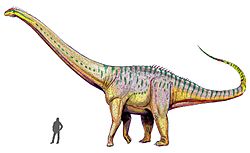Amphicoelias facts for kids
Quick facts for kids AmphicoeliasTemporal range: Upper Jurassic
|
|
|---|---|
 |
|
| Illustration - Amphicoelias fragillimus | |
| Scientific classification | |
| Kingdom: | |
| Class: | |
| Superorder: | |
| Order: | |
| Suborder: | |
| Genus: |
Amphicoelias
Cope 1878
|
Amphicoelias (say "am-fee-SEE-lee-us") was a huge plant-eating dinosaur. It lived about 150 million years ago during the Late Jurassic Period. Its fossils were found in what is now Colorado, United States. This dinosaur was quite long, reaching about 60 to 65 meters (around 200 to 213 feet)! It had very long, thin back legs and slightly longer front legs.
Amphicoelias: A Giant Plant-Eater
Discovery and Its Ancient Home
In 1877, some amazing dinosaur fossils were found in Colorado. They were discovered near a place called Canyon City. Among these fossils were parts of a backbone (dorsal vertebrae), a hip bone (pubis), and a thigh bone (femur). Scientists quickly figured out that these bones belonged to a type of long-necked dinosaur called a sauropod.
The American Museum of Natural History got these fossils in 1897. They learned that the bones came from the Late Jurassic period. This was a time when the area was part of the Morrison Formation.
The land where Amphicoelias lived looked a lot like today's savannas. But there was no grass back then! Instead, ferns were the main plants. These ferns were probably the main food for Amphicoelias. Scientists think that giant plant-eaters like Amphicoelias might have rested in the shade of forests during the day. Then, they would come out to eat in the open savanna at night to stay cool.
Images for kids
-
1897 restoration of aquatic A. altus, by Charles R. Knight, based on Cope's original.
See also
 In Spanish: Amphicoelias altus para niños
In Spanish: Amphicoelias altus para niños








